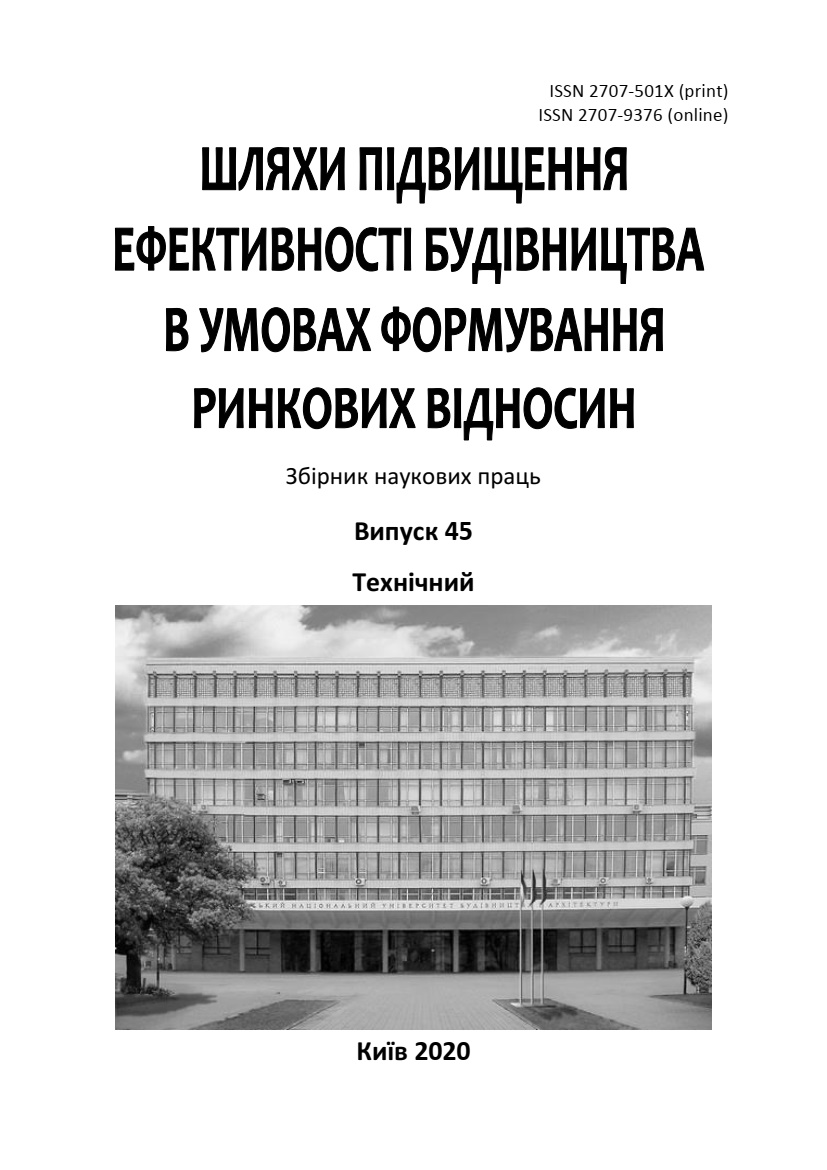Determination of technological parameters of soil compacting process
DOI:
https://doi.org/10.32347/2707-501x.2020.45.3-15Keywords:
soil compacting, technological parameters of soil compaction, construction technologies, rheological model, Fourier analysis of the experimental data.Abstract
The article is devoted to determine the technological parameters of soil compaction by rollers according to soil properties in construction. The compaction of the soil occurs due to certain force loads on the soil. Nowadays, there are enough methods to determine the technological parameters of soil compaction process, however, there are few research methods that consider the system of soil-machine-technological parameters. The urgency of the soil compaction process, which ultimately determines the quality of construction products, was emphasized. The basic physical and mechanical properties of soil and technological parameters of the compaction process were given. Analysis of discrete mathematical model of interaction between roller and soil was carried out in order to determine the technological parameters of soil compaction process in the field of construction technologies. A rheological model to describe the soil properties was used. The differential equations of the interaction between roller and soil have been made. A numerical calculation method to solve the differential equations has been proposed. The basic technological parameters of soil compaction process by rollers have been determined - the thickness of soil layer to be compacted, the number of the roller passes, and the speed of the roller movement. The methodology of theoretical and experimental researches of interaction between roller and soil has been proposed in order to clarify the mathematical model and to find the technological parameters of the compaction process. Experimental research methods are based on the determination of the stress-strain state of soil and on the Fourier analysis of the experimental data. Fourier analysis of the experimental data makes it possible to analyze the qualitative energy spectrum of the interaction between roller and soil to determine the rational amplitude-frequency characteristics of the compaction process. Experimental studies allow obtaining such rheological properties of soil as elasticity, viscosity, coefficient of elastic resistance, etc. The main recommendations for the choice of compaction method depending on the type of soil have been proposed.
References
Avalle, D.L. (2007). “Trials and validation of deep compaction using the “square” impact roller”. Symposium - Advances in Earthworks, Australian Geomechanics Society, Sydney, 6pp.
Brendan Scott, Mark Jaksa, Yien Lik Kuo. (2012). Use of proctor compaction testing for deep fill construction using impact rollers. International Conference on Ground Improvement and Ground Control (ICGI 2012), 30 Oct. – 2 Nov. 2012, University of Wollongong, Australia.
Басараб В.А. Дослідження полічастотного режиму коливань робочого органу електромагнітної ударно-вібраційної установки / В.А. Басараб // Управління розвитком складних систем № 34. К.: КНУБА, 2018. – С. 182 ‑ 187.
Белоногов Л.Б. Современные методы уплотнения грунтов. Выбор и расчет оборудования: учеб.-метод. пособие / Л.Б. Белоногов, Л.В. Янковский. – Пермь: изд-во Перм. нац. исслед. политехн. ун-та, 2012. -136 с.
Неклюдов М.К. Механизация уплотнения грунтов. – 2-е изд. доп. и перер. / Неклюдов М.К. – М.: Стройиздат, 1985. – 168 с.
Рейнер Маркус. Реология / Маркус Рейнер. – М.: Наука, 1965. – 223 с.
Сукач М.К. Будівельні машини і обладнання / М.К. Сукач – К.: Ліра-К, 2016. – 408 с.
Терновий В.І. Ущільнення ґрунтів у будівництві / В.І. Терновий, І.М. Уманець, Л.С. Саушева, О.С. Молодід – К.: ”ЦП КОМПРИНТ”, 2015. – 136 с.
Хархута Н.Я. Машины для уплотнения грунтов / Н.Я. Хархута – Л.: Машиностроение, 1973. – 176 с.
Хмара Л.А., Шатов С.В., Карпушин С.О. Удосконалення конструкції самохідних котків / Л.А. Хмара, С.В. Шатов, С.О. Карпушин // Строительство. Материаловедение. Машиностроение. №97. 2017. - С. 105-111.
Downloads
Published
How to Cite
Issue
Section
License
Copyright (c) 2020 V. A. Basarab

This work is licensed under a Creative Commons Attribution 4.0 International License.
Authors who publish with this journal agree to the following terms:
- Authors retain copyright and grant the journal right of first publication with the work simultaneously licensed under a Creative Commons Attribution License that allows others to share the work with an acknowledgement of the work's authorship and initial publication in this journal.
- Authors are able to enter into separate, additional contractual arrangements for the non-exclusive distribution of the journal's published version of the work (e.g., post it to an institutional repository or publish it in a book), with an acknowledgement of its initial publication in this journal.
- Authors are permitted and encouraged to post their work online (e.g., in institutional repositories or on their website) prior to and during the submission process, as it can lead to productive exchanges, as well as earlier and greater citation of published work (See The Effect of Open Access).

